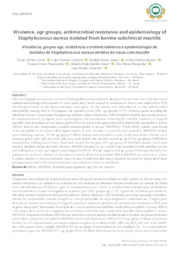Virulence, agr groups, antimicrobial resistance and epidemiology of Staphylococcus aureus isolated from bovine subclinical mastitis.
Virulence, agr groups, antimicrobial resistance and epidemiology of Staphylococcus aureus isolated from bovine subclinical mastitis.
Autoria: ZORZI, F. M.; ZAFALON, L. F.; SANTOS, F. B.; NASCIMENTO, T. G.; BASÍLIO JUNIOR, I. D.; MAMIZUKA, E. M.; ALMEIDA, L. M.
Resumo: Fifty-two Staphylococcus aureus recovered from papillary ostium and milk samples collected from cows with subclinical mastitis and milking environments in three small dairy herds located in southeastern Brazil were subjected to PCR identification based on the thermonuclease (nuc) gene. All the strains were submitted to in vitro antimicrobial susceptibility testing, and we investigated the sequence types (STs), agr groups (I-IV), virulence genes encoding for Microbial Surface Components Recognizing Adhesive Matrix Molecules (MSCRAMMs), biofilm-associated proteins, bi-component toxins, pyrogenic toxin superantigens, and enterotoxins. Screening for oxacillin resistance (2-6 μg/ml oxacillin), beta-lactamase activity assays, and PCR for the mecA/mecC genes detected 26 methicillin-susceptible S. aureus (MSSA) and 26 mec-independent oxacillin-nonsusceptible S. aureus (MIONSA). While MSSA isolates were found to be susceptible to all antimicrobial agents tested, or only resistant to penicillin and ampicillin, MIONSA isolates were multidrug-resistant. ST126-agr group II MSSA isolates were prevalent in milk (n=14) and carried a broad set of virulence genes (clfA, clfB, eno, fnbA, fiB, icaA, icaD, lukED, hla, and hlb), as well as the ST126-agrgroup II MIONSA isolated from milking liners (n=1), which also carried the etagene. ST1-agr group III MIONSA isolates (n=4) were found in papillary ostium and milk, but most MIONSA isolates (n=21), which were identified in both papillary ostium and milking liners, were agr-negative and assigned to ST126. The agr -negative and agr group III lineages showed a low potential for virulence. Studies on the characterization of bovine-associated MSSA/MIONSA are essential to reduce S. aureus mastitis to prevent economic losses in dairy production and also to monitor the zoonotic potential of these pathogens associated with invasive infections and treatment failures in healthcare.
Ano de publicação: 2021
Tipo de publicação: Artigo de periódico
Unidade: Embrapa Pecuária Sudeste
Palavras-chave: Accessory gene regulator (agr), MIONSA, MSSA
Observações
1 - Por padrão são exibidas publicações dos últimos 20 anos. Para encontrar publicações mais antigas, configure o filtro ano de publicação, colocando o ano a partir do qual você deseja encontrar publicações. O filtro está na coluna da esquerda na busca acima.
2 - Para ler algumas publicações da Embrapa (apenas as que estão em formato ePub), é necessário ter, no celular ou computador, um desses softwares gratuitos. Sistemas Android: Google Play Livros; IOS: iBooks; Windows e Linux: software Calibre.
Acesse outras publicações
Acesse a Base de Dados da Pesquisa Agropecuária (BDPA) para consultar o acervo completo das bibliotecas da Embrapa.

